lock CHEVROLET CAMARO 1967 1.G Chassis Workshop Manual
[x] Cancel search | Manufacturer: CHEVROLET, Model Year: 1967, Model line: CAMARO, Model: CHEVROLET CAMARO 1967 1.GPages: 659, PDF Size: 114.24 MB
Page 509 of 659

CHASSIS SHEET METAL 11-22
wiring harness, and washer bottle from radiator
support.
5.
Remove screw connecting battery tray to radiator
support.
6. Remove shroud from vehicle if so equipped.
7.
Remove shroud and radiator (Section 13).
8. Remove screws securing support to frame, skirts,
and fenders.
9. Remove radiator support from vehicle.
Installation
Install radiator support following the removal pro-
cedure in reverse order. Refer to torque specifications
in rear of manual for correct torque values for radiator
supportj grille, and bumper.
FENDER AND SKIRT ASSEMBLY
Removal
1.
Remove front bumper (Section 14).
2.
Remove hood and hood.hinges (two men).
3.
Remove bolts securing brace to skirt and dash panel
and remove brace (fig. 32).
4.
Disconnect any components attached to fender and
skirt such as cruise control, hoses, electrical har-
ness etc.
5.
Remove screws securing radiator support to fender
and skirt.
6. Remove headlamp bezel and headlamp.
7.
Remove screws securing fender and skirt assembly
to header panel, headlamp housing and valance panel.
Remove screw securing fender extension to valance
panel.
8. Remove screws securing fender and skirt assembly
to vehicle and remove fender and skirt assembly.
9. If necessary, remove screws attaching fender ex-
tension and bumper bracket to fender and remove
extension and bracket. Replace fender trim if nec-
essary.
Installation
Install fender anci skirt assembly following the removal
procedure in reverse order. Refer to torque specifi-
cations in rear of manual for correct torque values.
HOOD ASSEMBLY
Procedures for hood removal and installation for
Camaro are the same as for Chevrolet and Chevelle.
Refer to Chevrolet and Chevelle hood removal and in-
stallation procedures, Figure 35 for Camaro hood catch,
support, and lock plate, and Figure 37 for Camaro hood
and insulator.
HOOD CATCH AND LOCK (Fig. 35)
Removal
1.
Remove catch plate assembly by removing screws
retaining catch to header panel, center support, and
radiator support.
NOTE: Before removing hood lock plate from
hood, locate position on hood by scribing around
base of lock plate.
2.
Remove lock plate by removing screws retaining lock
plate to hood and remove lock plate.
Fig.
35 - Hood Catch, Support, and Lock Plate - Camaro
Installation
Install lock and catch plate following the removal pro-
cedure in reverse order. Refer to torque specifications
in rear of manual for correct torque values. Adjust lock
and catch plate as outlined under adjustment procedure
in this section.
HOOD TRIM AND INSULATION (Fig. 37}
. Figure 37 shows the installation details of the Camaro
hood ornament and insulation pad. The insulation and
ornament retainers and nuts are accessible from under
the raised hood.
COWL VENT GRILLE
.Procedures'for Camaro cowl vent grille replacement
are the same as for Chevrolet and Chevelle. Refer to
Chevrolet and Chevelle cowl vent grille replacement.
CHEVROLET CHASSIS SERVICE MANUAL
Page 514 of 659
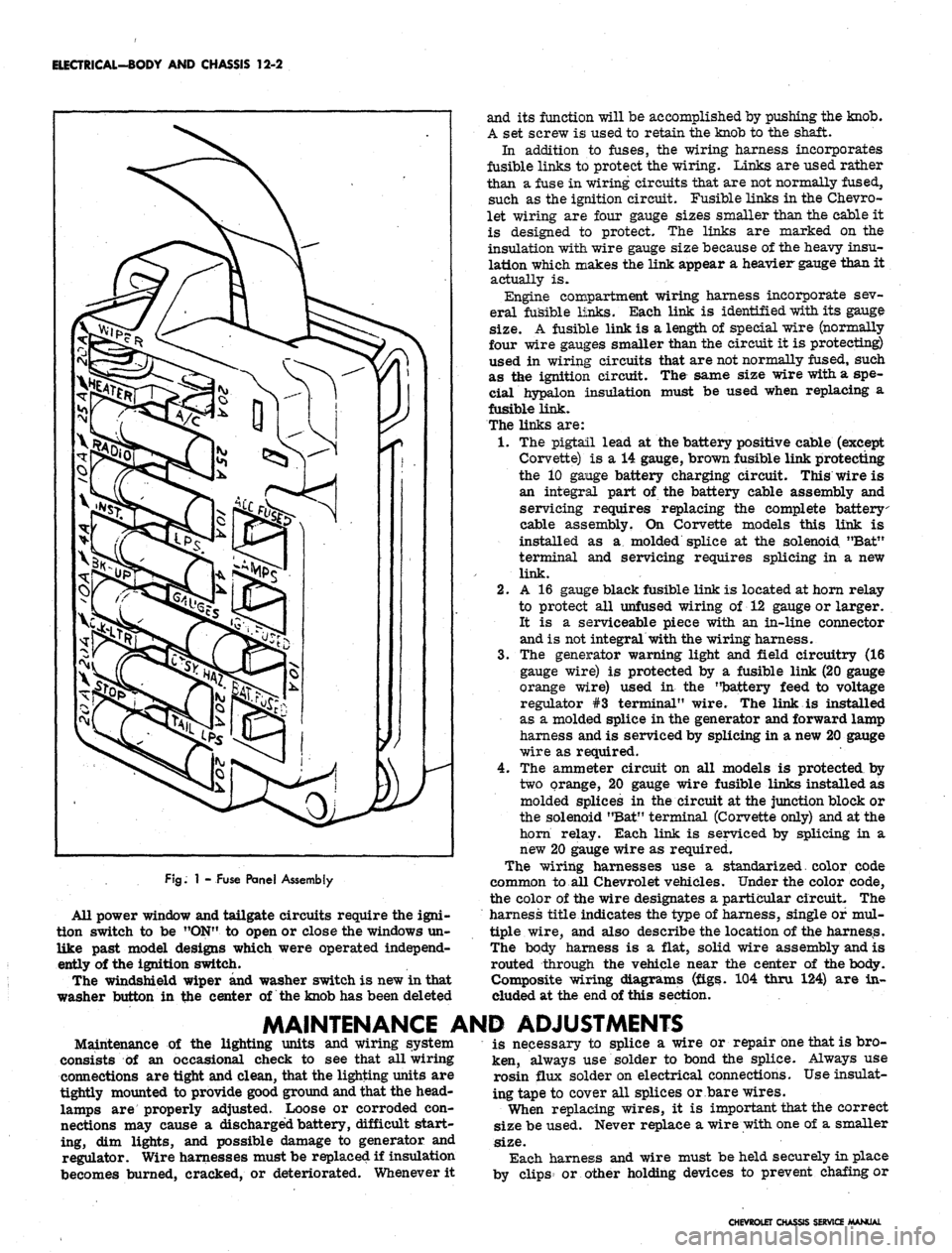
ELECTRICAL-BODY AND CHASSIS 12-2
FJg.
1 - Fuse Panel Assembly
All power window and tailgate circuits require the igni-
tion switch to be "ON" to open or close the windows un-
like past model designs which were operated independ-
ently of the ignition switch.
The windshield wiper and washer switch is new in that
washer button in the center of the knob has been deleted
and its function will be accomplished by pushing the knob.
A set screw is used to retain the knob to the shaft.
In addition to fuses, the wiring harness incorporates
fusible links to protect the wiring. Links are used rather
than a fuse in wiring circuits that are not normally fused,
such as the ignition circuit. Fusible links in the Chevro-
let wiring are four gauge sizes smaller than the cable it
is designed to protect. The links are marked on the
insulation with wire gauge size because of the heavy insu-
lation which makes the link appear a heavier gauge than it
actually is.
Engine compartment wiring harness incorporate sev-
eral fusible links. Each link is identified with its gauge
size.
A fusible link is a length of special wire (normally
four wire gauges smaller than the circuit it is protecting)
used in wiring circuits that are not normally fused, such
as the ignition circuit. The same size wire with a spe-
cial hypalon insulation must be used when replacing a
fusible link.
The links are:
1.
The pigtail lead at the battery positive cable (except
Corvette) is a 14 gauge, brown fusible link protecting
the 10 gange battery charging circuit. This wire is
an integral part of the battery cable assembly and
servicing requires replacing the complete battery
cable assembly. On Corvette models this link is
installed as a molded splice at the solenoid "Bat"
terminal and servicing requires splicing in a new
link.
2.
A 16 gauge black fusible link is located at horn relay
to protect all unfused wiring of 12 gauge or larger.
It is a serviceable piece with an in-line connector
and is not integral with the wiring harness.
3.
The generator warning light and field circuitry (16
gauge wire) is protected by a fusible link (20 gauge
orange wire) used in the "battery feed to voltage
regulator #3 terminal" wire. The link is installed
as a molded splice in the generator and forward lamp
harness and is serviced by splicing in a new 20 gauge
wire as required.
4.
The ammeter circuit on all models is protected by
two orange, 20 gauge wire fusible links installed as
molded splices in the circuit at the junction block or
the solenoid "Bat" terminal (Corvette only) and at the
horn relay. Each link is serviced by splicing in a
new 20 gauge wire as required.
The wiring harnesses use a standarized. color code
common to all Chevrolet vehicles. Under the color code,
the color of the wire designates a particular circuit. The
harness title indicates the type of harness, single of mul-
tiple wire, and also describe the location of the harness.
The body harness is a flat, solid wire assembly and is
routed through the vehicle near the center of the body.
Composite wiring diagrams (figs. 104 thru 124) are in-
cluded at the end of this section.
MAINTENANCE AND ADJUSTMENTS
Maintenance of the lighting units and wiring system
consists of an occasional check to see that all wiring
connections are tight and clean, that the lighting units are
tightly mounted to provide good ground and that the head-
lamps are properly adjusted. Loose or corroded con-
nections may cause a discharged battery, difficult start-
ing, dim lights, and possible damage to generator and
regulator. Wire harnesses must be replaced if insulation
becomes burned, cracked, or deteriorated. Whenever it
is necessary to splice a wire or repair one that is bro-
ken, always use solder to bond the splice. Always use
rosin flux solder on electrical connections. Use insulat-
ing tape to cover all splices or bare wires.
When replacing wires, it is important that the correct
size be used. Never replace a wire with one of a smaller
size.
Each harness and wire must be held securely in place
by clips or other holding devices to prevent chafing or
CHEVROLET CHASSIS SERVICE MANUAL
Page 516 of 659
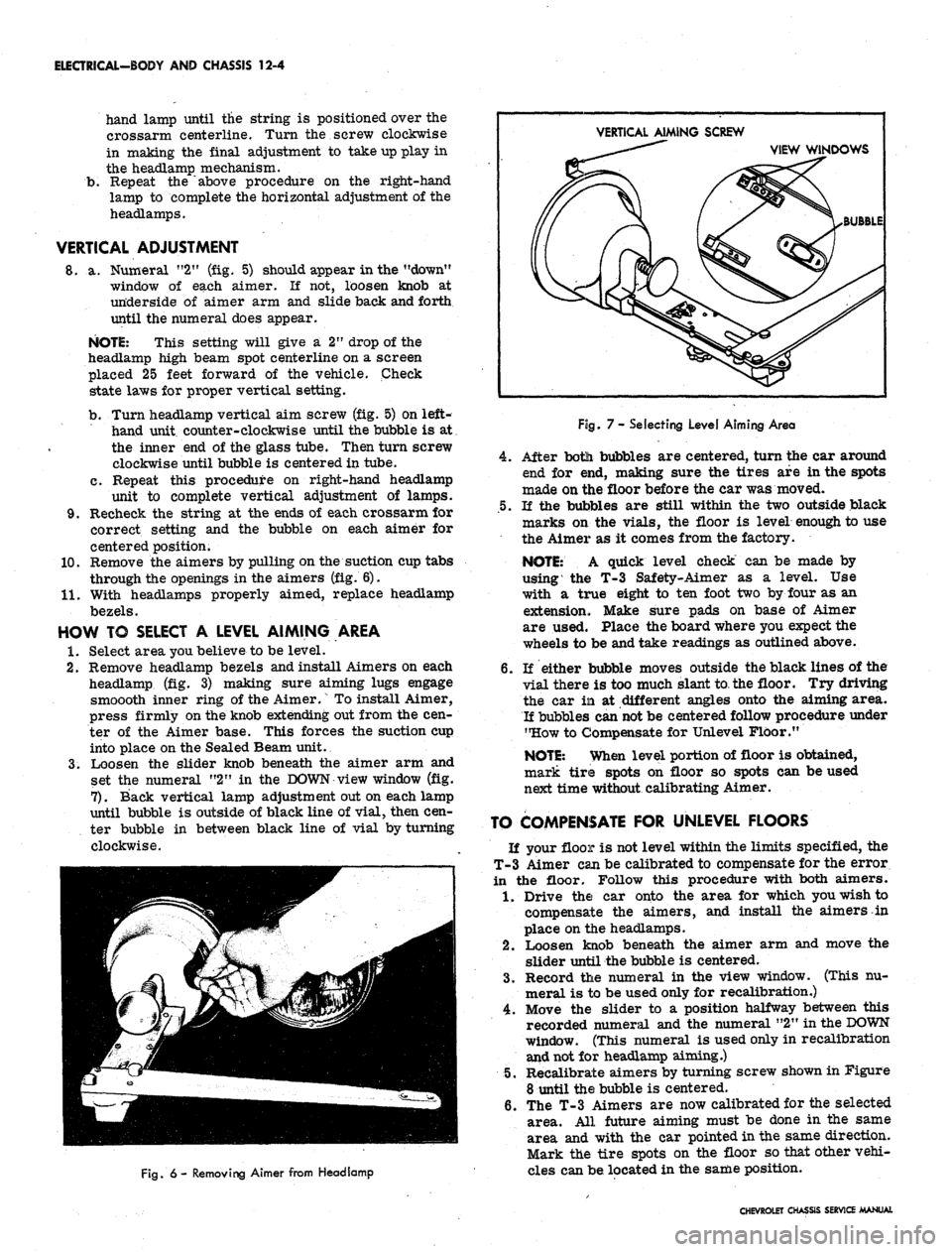
ELECTRICAL-BODY AND CHASSIS 12-4
b.
hand lamp until the string is positioned over the
crossarm centerline. Turn the screw clockwise
in making the final adjustment to take up play in
the headlamp mechanism.
Repeat the above procedure on the right-hand
lamp to complete the horizontal adjustment of the
headlamps.
VERTICAL ADJUSTMENT
8. a. Numeral "2" (fig. 5) should appear in the "down"
window of each aimer. If not, loosen knob at
underside of aimer arm and slide back and forth
until the numeral does appear.
NOTE:
This setting will give a 2" drop of the
headlamp high beam spot centerline on a screen
placed 25 feet forward of the vehicle. Check
state laws for proper vertical setting.
b.
Turn headlamp vertical aim screw (fig. 5) on left-
hand unit counter-clockwise until the bubble is at
the inner end of the glass tube. Then turn screw
clockwise until bubble is centered in tube.
c. Repeat this procedure on right-hand headlamp
unit to complete vertical adjustment of lamps.
9. Recheck the string at the ends of each crossarm for
correct setting and the bubble on each aimer for
centered position.
10.
Remove the aimers by pulling on the suction cup tabs
through the openings in the aimers (fig. 6).
11.
With headlamps properly aimed, replace headlamp
bezels.
HOW TO SELECT A LEVEL AIMING AREA
1.
Select area you believe to be level.
2.
Remove headlamp bezels and install Aimers on each
headlamp (fig. 3) making sure aiming lugs engage
smoooth inner ring of the Aimer.
"
To install Aimer,
press firmly on the knob extending out from the cen-
ter of the Aimer base. This forces the suction cup
into place on the Sealed Beam unit.:
3.
Loosen the slider knob beneath the aimer arm and
set the numeral "2" in the DOWN view window (fig.
7).
Back vertical lamp adjustment out on each lamp
until bubble is outside of black line of vial, then cen-
ter bubble in between black line of vial by turning
clockwise.
VERTICAL AIMING SCREW
VIEW WINDOWS
BUBBLE
Fig.
6 - Removing Aimer from Headlamp
Fog.
7- Selecting Level Aiming Area
4.
After botli bubbles are centered, turn the car around
end for end, making sure the tires are in the spots
made on the floor before the car was moved.
.5.
If the bubbles are still within the two outside black
marks on the vials, the floor is level enough to use
the Aimer as it comes from the factory.
NOTE:
A quick level check can be made by
using the T-3 Safety-Aimer as a level. Use
with a true eight to ten foot two by four as an
extension. Make sure pads on base of Aimer
are used. Place the board where you expect the
wheels to be and take readings as outlined above.
6. If either bubble moves outside the black lines of the
vial there is too much slant to the floor. Try driving
the car in at different angles onto the aiming area.
If bubbles can
not
be centered follow procedure under
"How to Compensate for Unlevel Floor."
NOTE:
When level portion of floor is obtained,
mark tire spots on floor so spots can be used
next time without calibrating Aimer.
TO COMPENSATE FOR UNLEVEL FLOORS
If your floor is not level within the limits specified, the
T-3 Aimer can be calibrated to compensate for the error
in the floor. Follow this procedure with both aimers.
1.
Drive the car onto the area for which you wish to
compensate the aimers, and install the aimers in
place on the headlamps.
2.
Loosen knob beneath the aimer arm and move the
slider until the bubble is centered.
3.
Record the numeral in the view window. (This nu-
meral is to be used only for recalibration.)
4.
Move the slider to a position halfway between this
recorded numeral and the numeral "2" in the
DOWN
window. (This numeral is used only in recalibration
and not for headlamp aiming.)
5.
Recalibrate aimers by turning screw shown in Figure
8 until the bubble is centered.
6. The T-3 Aimers are now calibrated for the selected
area. All future aiming must be done in the same
area and with the car pointed in the same direction.
Mark the tire spots on the floor so that other vehi-
cles can be located in the same position.
CHEVROLET CHASSIS SERVICE MANUAL
Page 517 of 659

ELECTRICAL-BODY AND CHASSIS 12-5
Fig.
8—Turning Level Adjusting Screw to Calibrate Aimer
HEADLAMP PANEL TRAVEL ADJUSTMENT
Corvette (Fig. 9)
The headlamp panel travel is limited by two adjusting
screws which are located on the arms of the shaft
mounted stop.
Fig.
9—Headlamp Panel Travel Adjusting Screw
1.
Raise hood and as a safety precaution install a bolt
through the hole in the hood support - secure bolt
with a nut.
2.
Adjusting screw (A) limits headlamp panel travel in
open position - adjust this screw so that mounting
face of panel is within 2 degrees of vertical in the
fully open position.
NOTE: Each headlamp operates independently
of the other, therefore individual adjustment is
required for each panel.
3.
Adjusting screw (B) limits headlamp panel travel in
closed position - adjust this screw so that panel is
flush to upper body panel in the fully closed position.
4.
Lock both screws by tightening lock nut against stop.
5.
Remove safety bolt as installed in Step 1 and close
the hood.
SERVICE OPERATIONS
FRONT LIGHTING
HEADLAMP REPLACEMENT (Figs. 10 and 13)
1.
On Corvette and Camaro Rally Sport models, rotate
the headlamp panel to the open position.
2.
Remove headlamp bezel retaining screws and remove
bezel. On Chevrolet, Chevelle and Camaro models
lift bezel to disengage retaining tabs from slots in
filler panel.
3.
On Chevy n models remove three retaining ring at-
taching screws. On other models disengage spring
from the retaining ring and remove two attaching
screws.
4.
Remove retaining ring, disconnect sealed beam unit
at wiring connector and remove the unit.
5.
Attach connector to replacement unit and position
unit in place making sure the number molded into the
lens face is at the top.
NOTE: In the dual headlamp installation the
inboard unit (NO. 1) takes a double connector, the
outboard unit (No. 2) takes a triple connector
plug.
6. Position retaining ring into place and install the re-
taining ring attaching screws and spring (as
applicable).
7.
Check operation of unit and install the headlamp
bezel.
PARKING LAMP REPLACEMENT
Bulb
1.
Remove two lens retaining screws and disengage lens
from housing.
2.
Replace bulb, check operation of lamp, reinstall lens
and retaining screws.
Lamp Housing
Chevrolet, Chevelle and Chevy II (Figs. 10 and 11)
1.
Disconnect lamp wire assembly in-line connector
from wiring harness.
CHEVROLET CHASSIS SERVICE MANUAL
Page 520 of 659

ELECTRICAL-BODY AND CHASSIS 12-8
is inserted through radiator support opening.
Remove two screws retaining lamp assembly to
lower sheet metal.
Remove three screws retaining lamp assembly to
lender.
To replace lamp assembly, reverse removal proce-
dure and check operation of the unit.
is aligned with flat on pivot shaft. Install stop lock
bolt and torque bolt to 45-60 in, lbs. Make sure that
side-to-side panel alignment is not changed when in-
stalling and tightening the stop.
CAUTION: Do not exceed specified torque
when tightening stop lock bolt.
HEADLAMP PANEL REPLACEMENT-CORVETTE
Refer to Figure 13 for Panel Mounting details.
1.
Remove engine compartment hood as outlined in
Section 1.
2.
Actuate headlamp panel to the open position.
NOTE:
In the event headlamp motor is inop-
erative, manual positioning of the panel can be
accomplished by turning the knurled knob at in-
board end of motor. As an assist in manual
operation of panel, apply light hand pressure to
panel in desired direction of rotation.
3.
Remove positive lead from battery terminal.
4.
Remove headlamp bezel retaining screws and bezel.
5. Remove the sealed beam housing unit as an assem-
bly - disconnect sealed beam leads at harness con-
nector and remove connector from sealed beam
leads;
remove the housing-to-panel retaining screws
and remove housing unit and wiring from panel.
6. Remove motor from panel pivot shaft - see motor
removal procedure. Then remove the panel stop
from panel inboard pivot shaft, and disconnect switch
lead wires from panel, support-mounted motor
switch.
7. Remove the panel retaining bolt access hole plugs
from inside the panel then rotate panel as required
and remove the retaining bolts and slide supports
from ends of panel pivot shaft. Remove bearing, felt
seal, retainer and washer from inboard pivot shaft.
8. Remove panel from its location by alternately disen-
gaging pivots from their retaining slots and with-
drawing unit forward through opening in body (fig.
14).
9. Loosen alien screw in spacer and disassemble parts
from the panel outboard pivot shaft.
10.
Install washer, retainer, felt seal, bearing and
spacer, in that order, to panel outboard pivot shaft.
Do not tighten spacer on shaft at this time.
11.
Position panel in body opening and index panel pivot
shafts in retaining slots; then loosely install support
retaining bolts.
12.
Install washer, retainer, felt seal, bearing and sup-
port, in that order, to panel inboard pivot shaft, and
loosely install support retaining bolts. -
13.
Check side-to-side alignment of panel, making sure
that there is no panel-to-body contact; position
spacer snugly against bearing; then tighten spacer
seat screw to 30-50 in. lbs.
14.
Install stop on panel inboard shaft so that it rests
against bearing, being sure that index mark on stop
15.
Check and align panel to body as follows:
a. Tighten panel pivot support bolts snugly but still
allowing panel to" be moved by applying hand
pressure.
b.
Position panel to the closed position and align
with body so that all surfaces are flush.
c. With the panel in the closed position the outboard
access hole is aligned with the forward bolt head.
Tighten this bolt with the panel in the closed
position - access to bolt head can be obtained by
working through opening between the hood and
body.
d. Rotate panel to obtain access to each bolt head
and torque bolts to 100-140 in. lbs.
e. Connect switch lead wires to support-mounted
limit switch.
16.
Install seaLed beam housing unit and at the same time
position sealed beam lead wires through panel out-
board pivot shaft. Install housing unit retaining
screws and install lead wires in connector, making
sure to match colors between harness and connector.
17.
Install motor assembly - see motor replacement
procedure.
18.
Connect positive lead to battery terminal.
19.
Adjust headlamp panel as outlined under "Headlamp
Panel Travel Adjustment".
20.
Adjust headlamp aiming as outlined under "Headlamp
Adjustment".
21.
Install headlamp bezel and engine compartment
hood - refer to Section 1 for hood installation.
Fig.
14
- Headlamp Panel Removal (Corvette)
CHEVROLET CHASSIS SERVICE MANUAL
Page 527 of 659
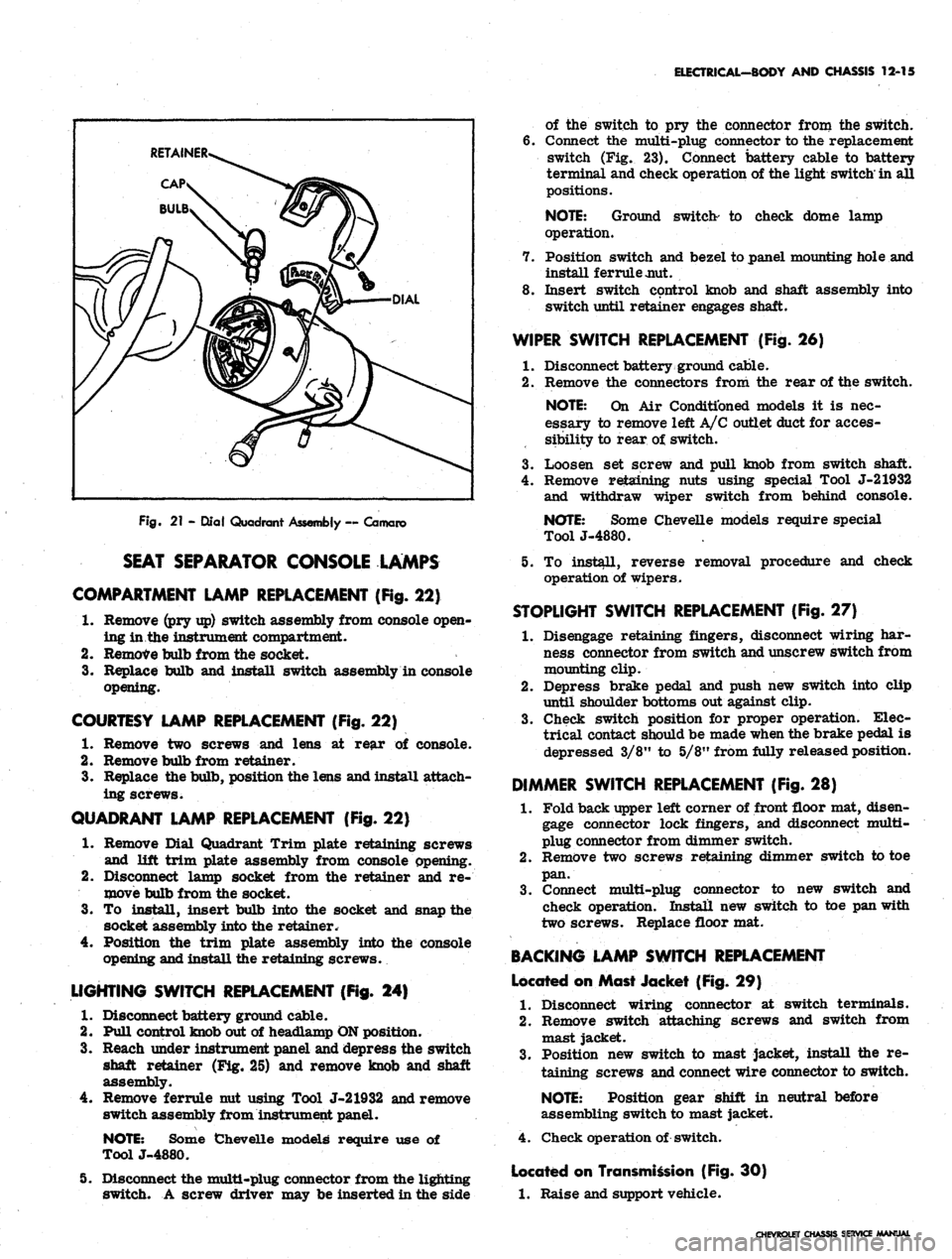
ELECTRICAL-BODY AND CHASSIS 12-15
Fig.
21 - Qlal Quadrant Assembly ~ Camaro
SEAT SEPARATOR CONSOLE LAMPS
COMPARTMENT LAMP REPLACEMENT (Fig.
22)
1.
Remove (pry up) switch assembly from console open-
ing in.the instrument compartment.
2.
Remove bulb from the socket.
3.
Replace bulb and install switch assembly in console
opening.
COURTESY LAMP REPLACEMENT (Fig. 22)
1.
Remove two screws and lens at rear of console.
2.
Remove bulb from retainer.
3.
Replace the bulb, position the lens and install attach-
ing screws.
QUADRANT LAMP REPLACEMENT (Fig. 22)
1.
Remove Dial Quadrant Trim plate retaining screws
and lift trim plate assembly from console opening.
2.
Disconnect lamp socket from the retainer and re-
move bulb from the socket.
3.
To install, insert bulb into the socket and snap the
socket assembly into the retainer.
Position the trim plate assembly into the console
opening and install the retaining screws.
4.
LIGHTING SWITCH REPLACEMENT (Fig. 24)
1.
Disconnect battery ground cable.
2.
Pull control knob out of headlamp ON position.
3.
Reach under instrument panel and depress the switch
shaft retainer (Fig. 25) and remove knob and shaft
assembly.
4.
Remove ferrule nut using Tool J-21932 and remove
switch assembly from instrument panel.
NOTE:
Some Chevelle models require use of
ToolJ-4880.
5. Disconnect the multi-plug connector from the lighting
switch. A screw driver may be inserted in the side
of the switch to pry the connector from the switch.
6. Connect the multi-plug connector to the replacement
switch (Fig. 23). Connect battery cable to battery
terminal and check operation of the light switch'in all
positions.
NOTE:
Ground switch- to check dome lamp
operation.
7. Position switch and bezel to panel mounting hole and
install ferrule jmt.
8. Insert switch control knob and shaft assembly into
switch until retainer engages shaft.
WIPER SWITCH REPLACEMENT (Fig. 26)
1.
Disconnect battery ground cable.
2.
Remove the connectors from the rear of the switch.
NOTE:
On Air Conditioned models it is nec-
essary to remove left A/C outlet duct for acces-
sibility to rear of switch.
3.
Loosen set screw and pull knob from switch shaft.
4.
Remove retaining nuts using special Tool J-21932
and withdraw wiper switch from behind console.
NOTE:
Some Chevelle models require special
ToolJ-4880.
5. To install, reverse removal procedure and check
operation of wipers.
STOPLIGHT SWITCH REPLACEMENT (Fig. 27)
1.
Disengage retaining fingers, disconnect wiring har-
ness connector from switch and unscrew switch from
mounting clip.
2.
Depress brake pedal and push new switch into clip
until shoulder bottoms out against clip.
3.
Check switch position for proper operation. Elec-
trical contact should be made when the brake pedal is
depressed 3/8" to 5/8" from fully released position.
DIMMER SWITCH REPLACEMENT (Fig. 28)
1.
Fold back upper left corner of front floor mat, disen-
gage connector lock fingers, and disconnect multi-
plug connector from dimmer switch.
2.
Remove two screws retaining dimmer switch to toe
pan.
3.
Connect multi-plug connector to new switch and
check operation. Install new switch to toe pan with
two screws. Replace floor mat.
BACKING LAMP SWITCH REPLACEMENT
Located on Mast Jacket (Fig. 29)
1.
Disconnect wiring connector at switch terminals.
2.
Remove switch attaching screws and switch from
mast jacket.
3.
Position new switch to mast jacket, install the re-
taining screws and connect wire connector to switch.
NOTE:
Position gear shift in neutral before
assembling switch to mast jacket.
4.
Check operation of switch.
Located on Transmission (Fig. 30)
1.
Raise and support vehicle.
CHEVROLET CHASSIS SERVICE MANUAL
Page 528 of 659
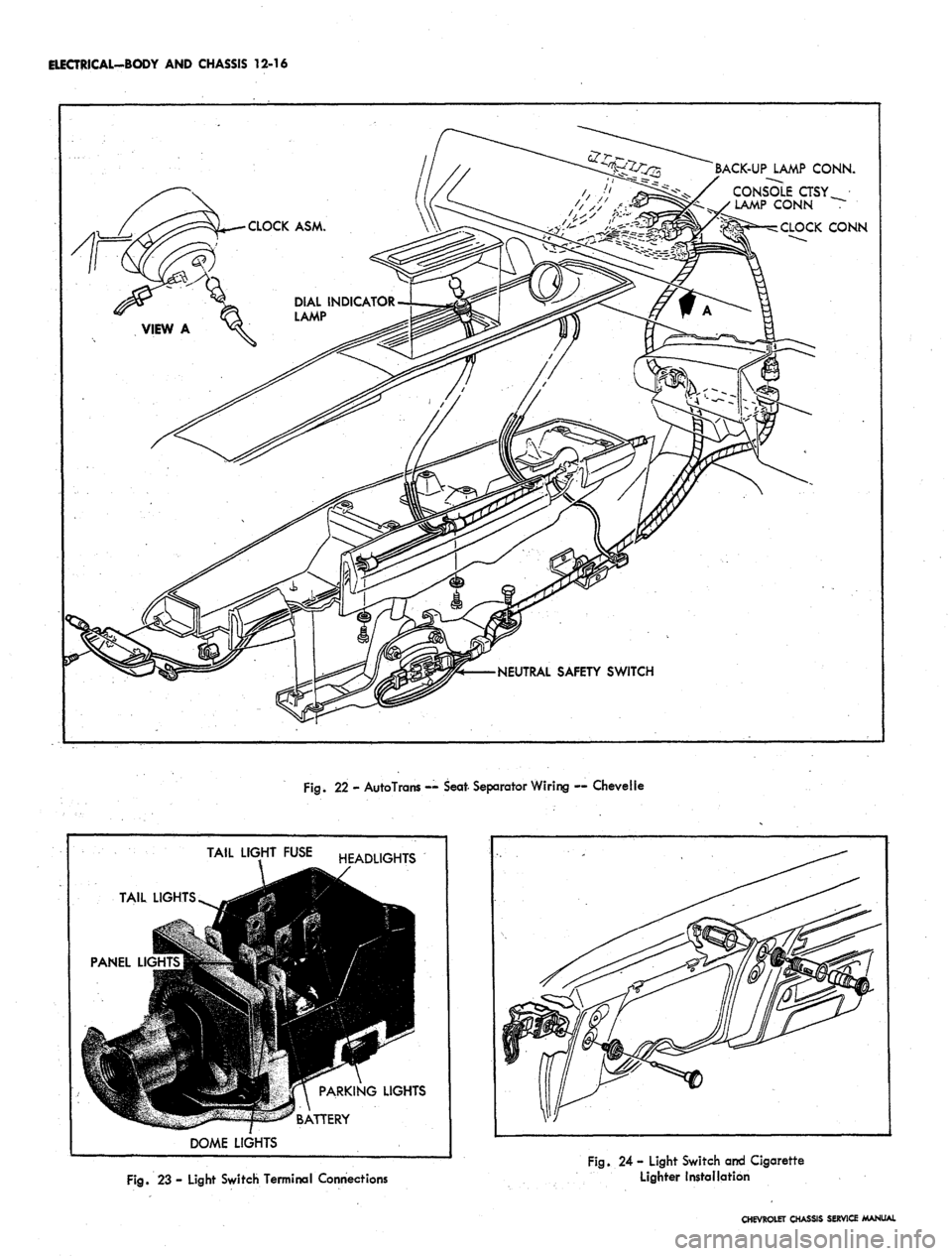
ELECTRICAL-BODY AND CHASSIS 12-16
BACK-UP LAMP CONN.
CONSOLE CTSY
LAMP CONN
CLOCK CONN
NEUTRAL SAFETY SWITCH
Fig.
22 - AutoTrans — Seat- Separator Wiring — Chevelle
TAIL
PANEL Ll<
J
TAIL
LIGHTS ^^g
9
""TUtflll -^ ""
DOME
LIGHT
r
•I
m
/
LIGHTS
FUSE HEADLIGHTS
9R
jl PARKING LIGHTS
*^ R ATTPRY
Fig.
23 - Light Switch Terminal Connections
Fig.
24 - Light Switch and Cigarette
Lighter Installation
CHEVROLET CHASSIS SERVICE MANUAL
Page 531 of 659

ELECTRICAL-BODY AND CHASSIS 12-19
VIEW A
•CONTACT SUPPORT
DRIVE SLOT IN LINE
WITH HOLE IN SWITCH
PAWL
CONTACT POINT B
CONTACT SUPPORT
DRIVE SLOT IN LINE
WITH HOLE IN SWITCH
FLOOR SHIFT
(EXCEPT CAMARO)
COLUMN SH
Fig.
31 - Neutral Safety Switches
PARKING BRAKE ALARM SWITCH REPLACEMENT
Corvette (Fig. 33)
1.
Remove seat belt retainer and parking brake cover
assembly from center console.
2.
Disconnect wire from brake alarm switch.
3.
Remove retaining screw and switch from
reinforcement.
4.
Position new switch to reinforcement and install re-
taining screw.
5. Connect switch wire and check operation of switch.
6. Install cover and seat belt retainer assembly.
Chevrolet, Chevelle, Chevy II and Camaro (Fig. 34)
1.
Disconnect wiring connector at switch terminal.
2.
Remove nut and lock washer or retaining bolt and
disengage switch from brace.
3.
To install, reverse removal procedure.
INSTRUMENT PANEL COMPARTMENT
LAMP/SWITCH REPLACEMENT
1.
Disconnect battery ground cable.
2.
Reach into glove box, depress bulb in end of switch
and turn counterclockwise to remove bulb.
3..
Remove switch from socket. Carefully detach wire
and terminal from switch.
NOTE:
On some model switches, the wire and
terminal cannot be detached from the switch
making it necessary to cut and splice the switch
wire.
4.
Insert wire and terminal into new switch.
5. Push switch into place and install bulb by setting it in
place, depressing and turning it clockwise.
CIGARETTE LIGHTER REPLACEMENT
Chevrolet, Chevy II, Camaro and Corvette (Fig. 23)
1.
Disconnect battery ground cable.
2.
Disconnect wire connector at rear of lighter unit
under dash.
3.
Remove retainer from rear of housing assembly and
disengage lighter unit from panel.
4.
To install, reverse removal procedure.
Chevelle (Fig. 35)
1.
Disconnect battery ground cable.
CHEVROLET CHASSIS SERVICE MANUAL
Page 533 of 659
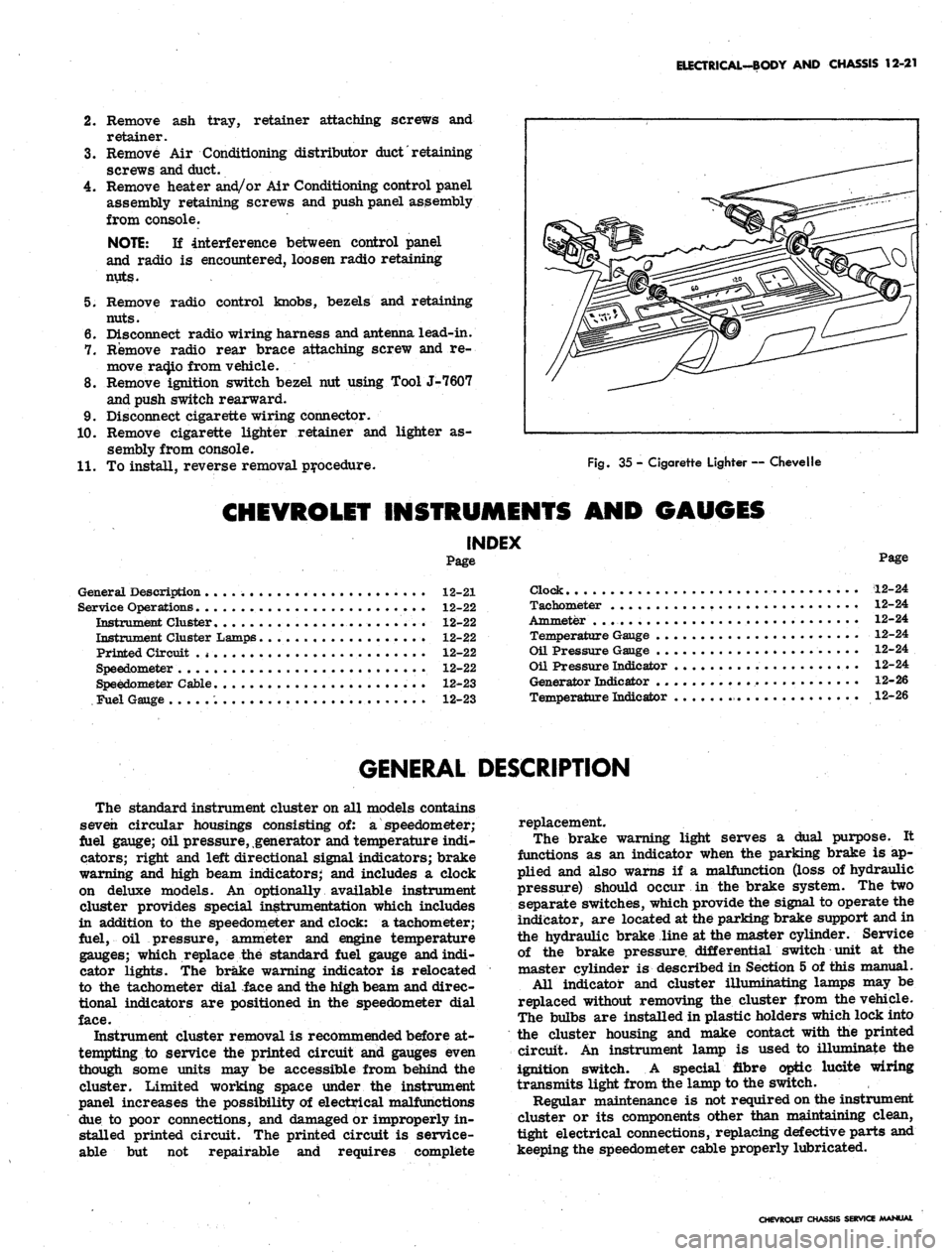
ELECTRICAL-BODY AND CHASSIS 12-21
2.
Remove ash tray, retainer attaching screws and
retainer.
3.
Remove Air Conditioning distributor
duct'
retaining
screws and duct.
4.
Remove heater and/or Air Conditioning control panel
assembly retaining screws and push panel assembly
from console.
NOTE:
If interference between control panel
and radio is encountered, loosen radio retaining
nuts.
5. Remove radio control knobs, bezels and retaining
nuts.
6. Disconnect radio wiring harness and antenna lead-in.
7. Remove radio rear brace attaching screw and re-
move ra(Jio from vehicle.
8. Remove ignition switch bezel nut using Tool J-7607
and push switch rearward.
9. Disconnect cigarette wiring connector.
10.
Remove cigarette lighter retainer and lighter as-
sembly from console.
11.
To install, reverse removal procedure.
Fig.
35 - Cigarette Lighter — Chevelle
CHEVROLET INSTRUMENTS AND GAUGES
INDEX
Page
General Description 12-21
Service Operations 12-22
Instrument Cluster........................ 12-22
Instrument Cluster Lamps 12-22
Printed Circuit .
* •
12-22
Speedometer 12-22
Speedometer Cable 12-23
Fuel Gauge 12-23
Page
Clock 12-24
Tachometer 12-24
Ammeter . . 12-24
Temperature Gauge 12-24
Oil Pressure Gauge 12-24
Oil Pressure Indicator 12-24
Generator Indicator 12-26
Temperature Indicator 12-26
GENERAL DESCRIPTION
The standard instrument cluster on all models contains
seven circular housings consisting of: a speedometer;
fuel gauge; oil pressure, generator and temperature indi-
cators; right and left directional signal indicators; brake
warning and high beam indicators; and includes a clock
on deluxe models. An optionally available instrument
cluster provides special instrumentation which includes
in addition to the speedometer and clock: a tachometer;
fuel, oil pressure, ammeter and engine temperature
gauges; which replace the standard fuel gauge and indi-
cator lights. The brake warning indicator is relocated
to the tachometer dial face and the high beam and direc-
tional indicators are positioned in the speedometer dial
face.
Instrument cluster removal is recommended before at-
tempting to service the printed circuit and gauges even
though some units may be accessible from behind the
cluster. Limited working space under the instrument
panel increases the possibility of electrical malfunctions
due to poor connections, and damaged or improperly in-
stalled printed circuit. The printed circuit is service-
able but not repairable and requires complete
replacement.
The brake warning light serves a dual purpose. It
functions as an indicator when the parking brake is ap-
plied and also warns if a malfunction (loss of hydraulic
pressure) should occur in the brake system. The two
separate switches, which provide the signal to operate the
indicator, are located at the parking brake support and in
the hydraulic brake line at the master cylinder. Service
of the brake pressure, differential switch unit at the
master cylinder is described in Section 5 of this manual.
All indicator and cluster illumihating lamps may be
replaced without removing the cluster from the vehicle.
The bulbs are installed in plastic holders which lock into
the cluster housing and make contact with the printed
circuit. An instrument lamp is used to illuminate the
ignition switch. A special fibre optic lucite wiring
transmits light from the lamp to the switch.
Regular maintenance is not required on the instrument
cluster or its components other than maintaining clean,
tight electrical connections, replacing defective parts and
keeping the speedometer cable properly lubricated.
CHEVROLET CHASSIS SERVICE MANUAL
Page 534 of 659
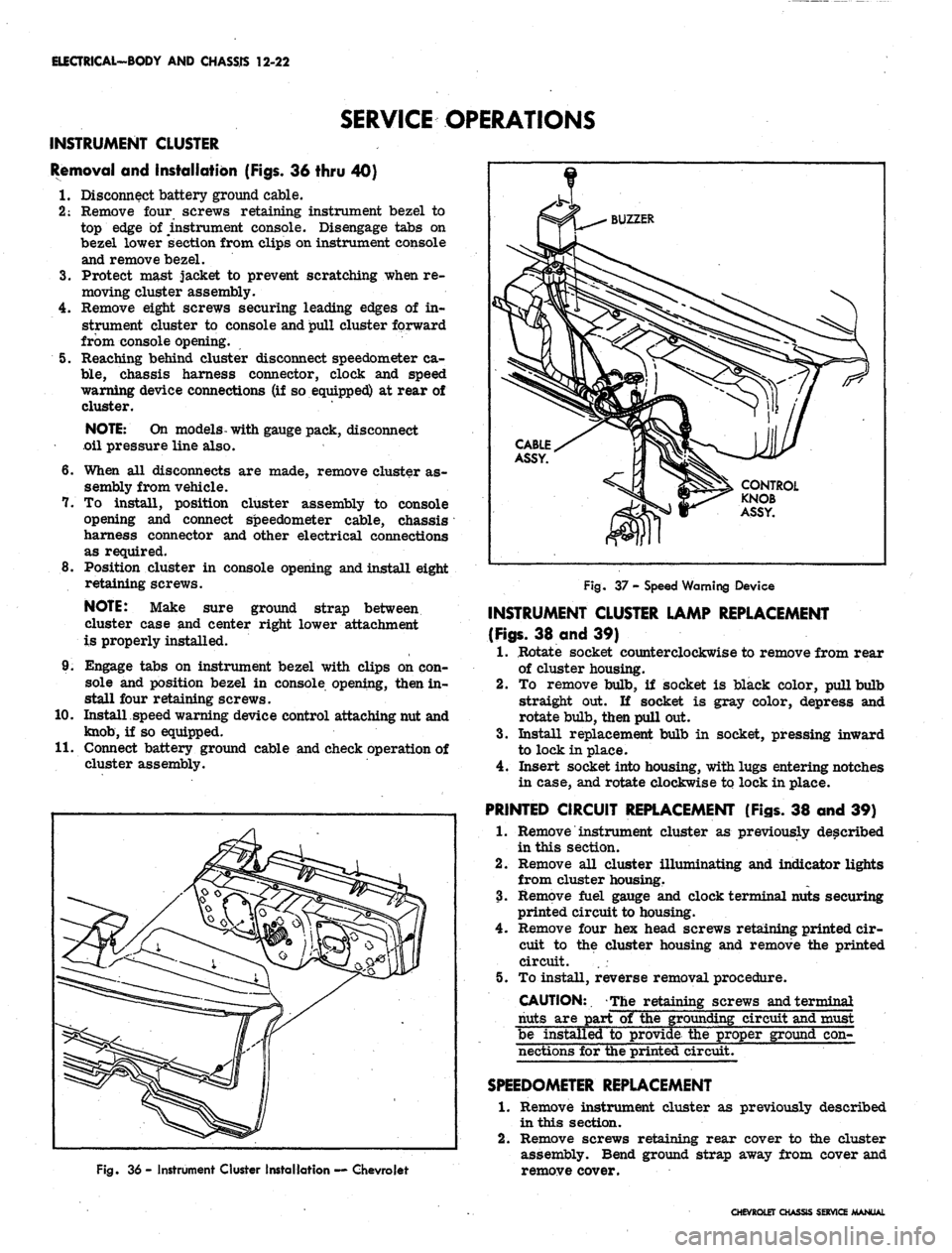
ELECTRICAL-BODY AND CHASSIS 12-22
SERVICE OPERATIONS
INSTRUMENT CLUSTER
Removal and Installation (Figs. 36 thru 40)
I. Disconnect battery ground cable.
2:
Remove four screws retaining instrument bezel to
top edge of instrument console. Disengage tabs on
bezel lower section from clips on instrument console
and remove bezel.
3.
Protect mast jacket to prevent scratching when re-
moving cluster assembly.
4.
Remove eight screws securing leading edges of in-
strument cluster to console and pull cluster forward
from console opening.
5. Reaching behind cluster disconnect speedometer ca-
ble,
chassis harness connector, clock and speed
warning device connections (if so equipped) at rear of
cluster.
NOTE:
On models- with gauge pack, disconnect
oil pressure line also.
6. When all disconnects are made, remove cluster as-
sembly from vehicle.
7. To install, position cluster assembly to console
opening and connect speedometer cable, chassis
harness connector and other electrical connections
as required.
8. Position cluster in console opening and install eight
retaining screws.
NOTE:
Make sure ground strap between
cluster case and center right lower attachment
is properly installed.
9. Engage tabs on instrument bezel with clips on con-
sole and position bezel in console opening, then in-
stall four retaining screws.
10.
Install speed warning device control attaching nut and
knob,
if so equipped.
II.
Connect battery ground cable and check operation of
cluster assembly.
Fig. 36 - Instrument Cluster Installation — Chevrolet
Fig. 37 - Speed Warning Device
INSTRUMENT CLUSTER LAMP REPLACEMENT
(Figs.
38 and 39)
1.
Rotate socket counterclockwise to remove from rear
of cluster housing.
2.
To remove bulb, if socket is black color, pull bulb
straight out. If socket is gray color, depress and
rotate bulb, then pull out.
3.
Install replacement bulb in socket, pressing inward
to lock in place.
4.
Insert socket into housing, with lugs entering notches
in case, and rotate clockwise to lock in place.
PRINTED CIRCUIT REPLACEMENT (Figs. 38 and 39)
1.
Remove instrument cluster as previously described
in this section.
2.
Remove all cluster illuminating and indicator lights
from cluster housing.
3.
Remove fuel gauge and clock terminal nuts securing
printed circuit to housing.
4.
Remove four hex head screws retaining printed cir-
cuit to the cluster housing and remove the printed
circuit. . .
5. To install, reverse removal procedure.
CAUTION:. The retaining screws and terminal
nuts are part of the grounding circuit and must
be installed to provide the proper ground con-
nections for the printed circuit.
SPEEDOMETER
REPLACEMENT
1.
Remove instrument cluster as previously described
in this section.
2.
Remove screws retaining rear cover to the cluster
assembly. Bend ground strap away from cover and
remove cover.
CHEVROLET CHASSIS SERVICE MANUAL